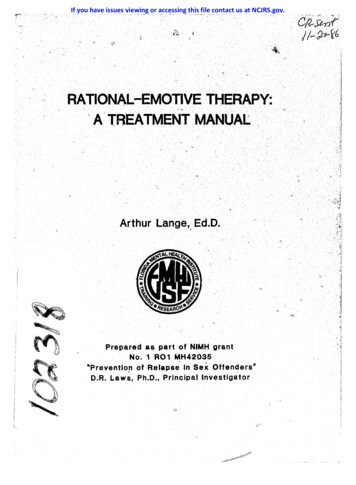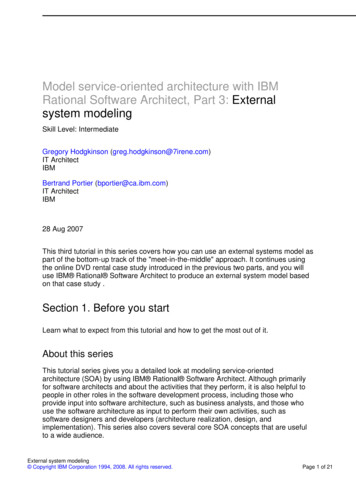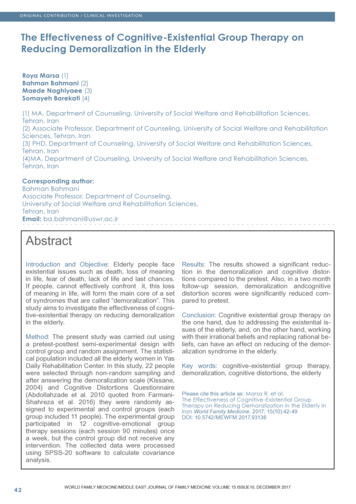
Transcription
If you have issues viewing or accessing this file contact us at NCJRS.gov. ·,·,·c1iikaf. /1 t9 fb. (?·,·'4. '. ·1'I. ".Q,"' .RATIONAL-EMOTIVE THERAPY:.,vA'TREATMENT MANl.JAt"pC,'I '",;',".,",,(j'.- 6Arthur Lange . Ed.D.oi!I ,:!Prepared as .part of NIMH grantNo.1 R01MH42035·Preventionof Relapse i'n Sex Offenders""D.R. Laws, Ph.D., Principal Investigator,yfj0.::,," 'I
102318U.S. Department of JusticeNational Institute of JusticeThis document has been reproduced exaclly as received from theperson or organlzallon originating it. Points of view or opinions statedin this document are those of the authors and do not necessarilyrepresent the oHiclal posilion or policies of the National Institute ofJustice.Permission to reproduce thisgranted byo i§lTledmaterial has beenPublic DomainNational Institute of Mental Bealthto the National Criminal Justice Reference Service (NCJRS).Further reproduction outside of the NCJRS system requires permission of the eopy;lgbt owner.Rational-Emotive Therapy:A Treatment ManualArthur Lange, Ed.D.prepared as part of NIMH grantNo. I ROI MH42035"Prevention of Relapse in Sex Offenders"D.R. Laws, Ph.D., Principal Investigator
Rational-Emotive Therapy:A Treatment ManualTable of ContentsUnderstand ngthe ABCs of RET1Three Types of Thinking7The Ten Irrational Ideas12Four Steps to Cognitive Restructuring15Changing Non-rational Cognitionssupporting Sexual Deviance19Practicing Cognitive RestructuringNCJRS23Strengthening Self-EfficacyAUG 25 198624Non-verbal Behavior/Unassertive,and Aggressive BehaviorAss rtiveACQU(5f.T.60NS31Conversation Skills39Practicing Assertive Behavior42Practicing of Cognitive and Behavioral Techniquesand Development of Self-Affirmation48Appendix I.51Appendix II.Appendix III.Appendix IV.Recommended ReadingsGoal Attainment ScalesIntegrity QuestionsUse of SurrogatesCognition ScaleAppendix V.Appendix VI.HandoutsInane Topics Exercise: Session XVI535557596383
The purpose of this manual is to train therapists to conduct20 hour and a half sessions using Rational-Emotive therapytechniques.Three target objectives will be the focus of thesessions:1)Teaching patients to challenge and ultimately eliminatethe rationalizations used to justify pedophilicbehaviors.2)Teaching patients to increase their sense of selfefficacy in two ways - a) I can control these deviantbehaviors, b) I can be interpersonally skilled in adultrelationships.3)Increasing self adequacy - increasing one'sinterpersonal effectiveness through cognitive andbehavioral skillstraining More generally, the goals for treatment are to have patientstake responsibility for their own behavior, to exercise greaterself control, and, for some, to develop better social skills.Thebottom line is total abstinence from levi ant sexual behavior bygetting the behavior under control and keeping it under control.
1Session One:Understanding the ABC's of R.E.T.Teaching the ABC's of Rational Emotive TherapySince this is the first actual treatment session it makessense to clarify what the 20 weeks will entail before startingwith the sUbstantive purpose of session one: understanding the A BC's and how to use them.Keep this introduction brief and to the point.the goals of the 20 weeks:First state1)eliminate rationalizations and denials that pedophilesuse to justify their deviant behavior and denyresponsibility for their own actions.2)increase their convictions that they can control theirdeviant thoughts and behaviors.---3)increase their conviction that they can have successfuland pleasurable relationships with adults.4)increase their interpersonal effectiveness in adultinteractions.Next, state the ultimate goal of total abstinence by gettingthe behavior under control and keeping it under control.These comments may warrant some elaboration or discussion butkeep it brief. You can now move right into the ABC's. I'llpresent here a way that you could present the ABC's. It is notoffered as "the" way but only as a very tangible example of howyou can do it."Let's get started.There are only three things that humanbeings can do, we do them all the time, 24 hours a day, you aredoing all three right now.The first thing we do is thinking,some of you are guessing what the three things are, some of youare thinking about something I've said about the goals oftreatment, and some of you are thinking about something totallydifferent, but we are always thinking!The second thing we do isfeel something and I don't mean hot or cold, pain, or tired butsome emotion like angry, anxious, frustrated, excited, happy,upset, calm, depressed, or guilty.Sometimes the feeling is
2strong and sometimes we're barely aware of it, but we are alwaysfeeling something.And thirdly, we are always behaving.You might pick one person and point out several smallbehaviors.You see, Bill, you just moved your finger and now you'veshifted in your seat and now you're smiling and hoping I'd stopthis real soon.Bill, even if you didn't move a muscle, sittingin that chair is a behavior.As long as we are alive, we arebehaving inside (heartbeats, breathing) and outside.Now we all know that we think, feel, and act.That's nothingnew, but it's a great place to start because the next question toask is:why to I think, feel, and act the way I do in specificsituations?Some of us might explain our behavior, any behavior,by saying "that's the way I am" or "I've always been that way" or"I was born that way" as though it's genetic or hereditary.Others would say, "no, I've been conditioned.My past experiencesand other people make me feel and act the way I do today."Well, both are somewhat true because they both can influencewho you are today, but there is a third explanation that is themost powerful and important of all.You have the capacity todirect and control the way you think, feel and act and the onlyreason people often don't is because they don't know how.Knowinghow to be powerful and how to exercise self control and how totake good, healthy care of yourself is not something everyoneknows or was born with.These sessions are designed to give youthe skills and techniques to direct and control the way you wantto handle situations so that you are more powerful and you aretakingbett care of yourself every day.,After you've practiced
3these skills they become part of your natural way of dealing withsituations but at first you must practice systematically andconsciously every day.The first thing I want to show you is the model for directingand controlling your thinking, feelings, and behaviors, it'scalled the A B C's.Use a blackboard and put ABC at top aswide apart as possible.Now, there are three screwball feelings that always keep us fromhandling situations effectively.anger, depression, and guilt.They are excessive anxiety,By excessive, I mean that youover-reacted by your own judgment.You know when you have gottenoverly angry, upset, frustrated, or anxious about something mostof the time.I am not saying you should never be angry, anxious,sad, or guilty, but only when you are over-reacting does it getyou in trouble.You might put the four feelings on theboard off to the side of the A B C's andinclude the word excessive above them.Now, A's represent any situation or person in a situationwhere you might get overly anxious, angry, depressed or guilty.Think of some general situations that people often over-react to.They don't have to be major events, just day-to-day situations onthe job or ·in your personal life."Note: Dr. Laws and I decided it would be better tostart with general situations rather than those relatedto deviant sexual behavior because a) it would be morecomfortable and b) we will need to work on generalsituations later when we get to self efficacy and selfadequacy Get the participants to list about 10 - 12situations on the job or in their personal lives; givesome examples yourself but get them to do most of thework. Example: job interview, performance evaluation,
4being criticized by boss especially unfairly, speakingin front of a group, dealing with traffic, dealing witha difficult colleague, meeting new friend, meetingpossible romantic relationships, dealing with conflictswith relatives, spouses, lovers, moving, changing jobs,divorce, ending a relationship, loneliness, boredom."O.K., we have lots of A's, now C's represent two things,your feelings and your behavior in these situations.For example,you are going to an important job interview, what's the likelyfeeling if you got yourself overly something?Refer back to the four excessive feelings on the boardand have them choose the most likely.O.K., anxiety.Now what are some things you might do while youare in the outer office waiting to go into the interview?Get the participants to list behaviors: fidget, paceup and down, sweat, rifle through a magazine upsidedown. You pick three more A's using ones that theycontributed and try to use ones that would lead todifferent emotional responses - anger, anxiety,depression, guilt. Get the participants to describethe behaviors that result from that feeling.O.K.Now here's the first major point about the ABC's -feelings cause behaviors.determine how you act.The way you feel in a situation willBut that's only the beginning.Feelingsmay cause behaviors, but what causes us to feel the way we do in aspecific situation?that A's Most people make this mistake:they believeC's and it is not true but we think that way, wetalk that way, and we act that way.If I saw someone looking veryupset about something and I asked what's wrong, they'd typicallysay it was because of some A - I've been on the freeway for twohours and I missed my appointment or I've got an important jobinterview this afternoon.It's very natural to explain ourfeelings and behavior by saying Afs cause it, but it simply isn't
5true.A's do not cause C's.feel and act the way we do.People and things do not cause us toActually what really happens is thatwe run into a person or situation or problem at point A and thensomething happens to us at point Band then" we feel and act atpoint C.What do you think we do atpoint B?The participants might say "you choose, decide, react,size up, judge, etc. They all fall under the rubric we think.That's right, we think about the situation and then we feel andact at point C.The way you think at point B actually determineshow you feel and act at point c.I would go so far as to say, it's not what is true at point A hatcounts, it's what you think is true at point B that willdetermine how you feel and act at point C.If you think that youcan't stand criticism you will have difficulty when your bosscriticizes you fairly or unfairly.If you worry (think) too muchabout what people think of you, you will fear rejection and avoidsituations where you might get rejected.If you believe that youcan't stand it when "things" don't run smoothly, then you willmake yourself upset and frustrated when they don't.What I am saying is that each of us is responsible for ouractions and reactions at point C.As much as we would like to putthe blame on the A's (it's easier and more comfortable), it is nottrue."At this point have the participants give their ownexamples of how B's cause C's using either theexamples of A's cited earlier or new ones. Encouragethem to ask questions and check their understandingof the relationship between A's, B's, and C's.Homework: Have the participants return with fourcompleted examples of the ABC model where they:1)
6cited the situation, 2) identified the feelings andbehaviors at point C, and 3) listed the thoughts atpoint B that caused them to feel and act as they didat point c.During this session, do not use any situations thatinvolve deviant sexual behavior but you might makereference to them and that you will work on them nextweek.*See Appendix V for handout for Session One.
7Session Two:Three Types of ThinkingFirst discuss homework. Be sure that everyone hasaccurately completed descriptions of real situationsusing the ABC model. Clarify any mistakes orquestions.Second, begin the teaching aspect of this session."If B's, your thoughts, are the cause of your actions atpoint C, we better understand more about how we can think at pointB.There are three ways you can think at point B.You can thinkirrational thoughts, rational thoughts, or rationalizations.Thebad news is that two of the three ways you could think are lousy,that is, they lead to emotional over-reactions and dysfunctionalbehavior.The first type of thinking you could do is irra.tionalthinking.There are two types of irrational thinking, the firstis called catastrophic thinking.We catastrophize about all kindsof events.Note: this information should be put on theboard and added to as the presentation continues:Irrational ThinkingRational ThinkingRationalizationEvery catastrophic thought could start with the phrase:"What if . . ?"For example, you are going to a very important jobinterview, what are some of the "what if's" you could ask yourselfthat by the time you get there you're a nervous wreck?Get answers to this questions and elaborate on "whatif's" people might think before, during and after theinterview. Get the group fully involved in citing"what if's.ll You might also cite and example relatedto personal rejection and the "what if's" that goalong with it.
8It's the answer to the question that makes it catastrophic.You could think "What if the interviewer asks me to explain myThat's not alast three years of work?" and plan an answer.catastrophic thought, that's problem solving.But if you asked"What if the interviewer asks me to explain my last three years ofwork?" and the answer is "That would be awful.terrible!"Then you are catastrophizing.type of thinking "awfulizing."That would beThat's why we call thisWe want you to recognize when andhow you are "awfulizing" about things in specific situations."Note:the blackboard should now look like this:Irrational Thinking1)Rational ThinkingRationalizationcatastrophic thinking"What if . ?Awful!"Awfulizing"The second type of irrational thinking is calledabsolutistic thinking, another ten dollar term.comes out in an entirely different form:Absolute thinking"I must, I should, I'vegot to, I have to, I need to, I ought to . "Instead ofawfulizing, sometimes we are extremely self critical where we areconstantly criticizing our every behavior:I should have handledthat person more assertively, I shouldn't let people talk to methat way, I've got to be more successful, I should be able tohandle these situations better.Sometimes the critical thoughts run all day long.It soundslike the guy on the Federal Express commercial who talks so fastyou can't hear him, only it's in our own head.We learn veryearly in our lives to be self critical and to "should" on
9ourselves and some of us get very good at it.We "should" onourselves without even noticing."Note:the blackboard can now include:Irrational ThinkingRational ThinkingRationalization1) Catastrophic thinking"What if . ?Awful! "Awfulizing2) Absolutistic thinkingI must; I should, I've got to, I need to, I have to, Iought to .Shoulding"At the exact opposite end of the continuum isrationalization.Instead of over-reacting like with awfulizingand shoulding, rationalizations are exactly the opposite:what," "who cares," "big deal;" they are cons and denials."soSexoffenders use rationalizations regularly and they are great at it.What are some of the rationalizations sex offenders use to justifytheir own behavior?"This is a critical question. Be sure to get theparticipants focused on how they 1) rationalizebehaviors that they know are the beginnings of theirdeviant behavior chain, 2) rationalize their owndeviant sexual behavior by claiming the child enjoyedit, 3) rationalize by denying the severity orfrequency of their deviance by denying violentaspects of the behavior or the extent of sexuallydeviant behavior in which they have engaged."Rationalizations are designed to avoid self criticism and totry to legitimize behaviors which are pleasurable but are notacceptable.They are denials of major parts of the reality of the
10situation.And they leave you vulnerable to engage in dangerousbehavior.Besides rationalizing deviant sexual behavior, sex offendersoften also rationalize their ability to exercise self control:"Ican't help myself," "I've always been like this," "Maybe I wasborn this way," "I can't control my thoughts or my actions", "It'stoo powerful, I can't stop myself."These are cons and denialsthat leave you powerless to use the resources you do have tocontrol your own behavior and they imply that you are thereforenot responsible for what you do.That's a con and you are denyingyour own power to exercise self control."At this point you might ask the participants to giveexamples of ways they con themselves out of takingresponsibility by disavowing their ability to controlthemselves. The blackboard would now look like this:Irrational ThinkingRational Thinking1) Catastrophic thinking"What if . ? Awful!"Awfulizing2) Absolutistic thinkingI must, r should,I've got to, I need to,I have to, I ought to . .ShouldingRationalizationso whatwho caresbig dealconsdenials(list examples ofrationalizationsjustifying deviantbehavior, denyingseverity, anddenying ability toexercise selfcontrol)"The third type of thinking, rational thinking, is the mostfunctional and most powerful of all.These thoughts are stated asRealist (vs. catastrophic) Preferences (vs. absolutes):I'd like, I'd prefer, It would be better if .I want,For example, whenyou are anxious about someone rejecting you or angry and
11frustrated about a failure, instead of awfulizing and shouldingabout it, you would force yourself to think in terms ofpreferences. If you failed at some task,it sunfortunate, youmight be disappointed but it's not awful, terrible, and horrible,nor should you "should" on yourself for having failed.Conversely, if you find yourself rationalizing or justifyingdeviant thoughts or actions, you would attack therationalizations, the cons, and replace those thoughts with morerational alternatives like:I "I am responsible for my actions andcontrol myself if I choose to do so.decide what I'll do.I do have the power toI might like these fantasies of deviantbehavior but I don't have to have them.I decide what I thinkabout and how I act."At this point in the session get participants tovolunteer specific situations where they might getoverly anxious, angry, depressed, or guilty. Havethem identify the thinking that causes the feelingsand actions at point C and have them categorize thethinking as awfulizing, shoulding or rationalizing.Then have them identify more rational alternatives.Start with day-to-day work or social situations whichmay lead to anxiety, anger, depression or guilt.Then move to situations where the participants userationalizations to justify deviant behavior, to denyits severity, or to deny their ability to controltheir thoughts or actions. Have them developrational alternatives to attack the rationalizations.Homework: have the participants return with at leastfour incidents where they over-reacted with excessiveanxiety, anger, depression, or guilt or where theyfound themselves awfulizing, shoulding, orrationalizing and have them list the specificthoughts they thought. They do not have to havechallenged them or substituted rational alternativesbut if they do, have them list the rational attacksthey used.*See Appendix V for handout for Session Two.
12Session Three:The Ten Irrational IdeasStart the session with a brief review of irrational,rational, and rationalized thinking asking theparticipants to describe each or give examples. It'sessential that they develop a readily availableability to recognize all three types of thinking andto tell the differences among them. Review thehomework assignment emphasizing the ability todiscriminate between irrational, rational,rationalized thinking. Try to get examples of allthree contexts: a) adult, day-to-day interactions orsituations, b) rationalizations of deviant thoughtsor actions, c) rationalizations of one's ability toexercise self control.After going through several examples and clarifyingmisunderstandings, present the list of thenirrational ideas to each group member."Here is a list of 10 irrational beliefs that most of us haveactually believed at some time in some situation.The 10 beliefsare generalizations, they are not the actual thoughts you think ina specific situation.The first four are the most important ofall because they occur most often and are the most powerful.Thefirst irrational belief has to do with worrying too much aboutwhat others think of you.It leads to awfulizing and avoidance ofadult situations where you might get rejected.It leads to beingoverly sensitive to criticism, defensiveness, and conflict withadults.The second belief has to do with fear of failure.If youare afraid to fail you will not take risks, avoid many situationsyou could have enjoyed, be overly competitive, be overly selfcritical and critical of others.to low frustration tolerance.The third belief usually leadsIf things don't go right, I can'tstand it and I'll get very upset.This kind of self indulgencesoften leads to deviant behavior as a safe compensation for the
,-- ------13frustrations you didn't deal with.When you get overly upsetbecause things are not going right or because you weren't treatedfairly, deviant behavior often returns or increases.Consequentlychallenging these beliefs is essential rather than avoiding them.Lastly, if rejection or failure occurs or if things don't goright, then someone is to blame.The tendency to blame oneselfleads to a low self worth and a tendency to blame others leads torationalizations justifying your deviant behavior.Thealternative is not to seek blame but to accept responsibility whenit is appropriate and to do what it takes to change.The other six ideas influence us all to some extent, but sexoffenders tend to believe #7, #8, and #9 as well.beliefs are what rationalization is all about:These threeit's easier toavoid or deny unpleasant truths, other people and situations makeme do what I do and I have little or no responsibility for myactions, my past determines how I think and act today and I havelittle control over myself.All three of these are cons.Eachone has a little bit of truth to it, but they get used and abusedto avoid taking responsibility for our behavior."At this point ask the participants to cite specificexamples of what they think in specific situationsthat would fall under the three generalrationalizations cited above. The purpose of thissession for the participants is to recognize andcategorize the types of thinking they do that eithersupports deviant sexual behavior or contributes totheir not handling adult situations.Homework: Have the group members record at leastfour incidents where they were either awfulizing,shoulding, or rationalizing and have them selectwhich of the ten irrational ideas are supporting orunderlying the specific thoughts in that situation.The purpose is to get the participants to be thinkingabout their thinking using the categories of
14awfulizing, shoulding, and rationalizing and to tiethem to the ten irrational beliefs. The groupmembers must know these principles cold or theycannot use the techniques fully.*See Appendix V for handout for Session Three.
15session Four:Four Steps for Cognitive RestructuringThis session is the one to pull all the cognitiveinformation together and to apply it to specificsituations. First, review the homework assignment,checking to see that the participants can accuratelyconnect awfulizing, shoulding, and rationalizing tothe ten irrational beliefs. Then pass out the sheetwith the four steps for cognitive restructuring."This four step process is what we have been building up toin the last three sessions.This is the process you can use tochallenge and change any rationalizing or over-reacting you mightdo that contributes to deviant sexual behavior.If you are goingto get control of the behavior you also need to get control of thethinking you do that gets the whole sequence started.Let's go through the four steps.I want you to work on a specific situation that's real for you where you think you wereoverly upset, frustrated, anxious, angry, depressed, or guilty.In step one you are to identify your 'internal dialogue,' that'swhat you were thinking to yourself, the specific thoughts, aboutyourself, the others in the situation, or the situation.Forexample, if I had a performance evaluation and it was a bad oneand I found myself getting very upset about it, what are some ofthe things I might be thinking to myself about myself that wouldmake me upset?What might I be thinking to myself about theothers in the situation like my boss?And what might I bethinking to myself about the situation (I get a bad evaluation andthat means I have no future here and I have to get another job,that's awful!)?Take a minute to write out all the thoughts thatcame to your mind in your own situation about yourself, the
16others, or the situation itself.You might have more thoughts inone category than the other two, but check all three for anythinking that contributed to your over-reaction.In step two, you simply identify which of the ten irrationalideas from the list we used last week are supporting your thinkingin your situation.Is it #1 fear of rejection, #2 fear offailure, #3 low frustration tolerance or unfairness, some type ofrationalization like #7, #8, or #9, or one of the others on thelist?More than one irrational belief is often operating so checkthem all out.Now that you know what thinking is causing this over-reactionand what irrational beliefs are behind it, you can attack them andchange them.In step three, you ask yourself two questions. First, what is true that you were thinking?For example, let'ssay I had the performance evaluation and it was a negative one.It's true that I am criticized; I did get a bad evaluation; itmeans I won't get promoted; I am not respected as fully as I'dlike by my boss; I may choose to look for another job.is true.Then I ask myself what is not true.I can't stand to be criticized.have my boss's respect.All thatIt is not true thatIt is not true that I have toIt is not true that it would be awful ifI didn't get promoted or if I had to look for another job.not true that I am a failure.It isNor is it true that getting upsetor depressed is going to make things any better.Now the key to this process is what de you think to yourselfinstead of the awfulizing, shoulding, or rationalizing you hadbeen doing in step one.One tendency might be to go to the other
17extreme and rationalize: so what if I got a bad evaluation, Idon't like this lousy job anyway; oh, that boss is a jerk, hedoesn't know anything about my work; it's all other people's faultand they are using me as the scapegoat; I just have a personalityconflict with him, he's threatened by me.Surely in some casesthese explanations may have some truth to them, but they are oftendistortions or avoidances.Try substituting realist preferences:I want, I'd like, I'd prefer, it would be better if .Forexample, in my situation, I'd like to have gotten a goodevaluation; I'm disappointed in the one I got, but it's not awful,terrible and horrible; I'd like to have the respect and support ofmy boss because he can influence my advancement, but I don't haveto advance here; I am not a failure because I have not done wellat this job; if I disagree with the evaluation, I can doeverything I can to correct his misunderstanding or I can leave;if his evaluation is accurate, then I need to either shape up mywork or do something else, but getting upset or depressed is notdoing any good.I don't like getting a bad evaluation, butit's not awful, terrible or horrible.List several rational thoughts that you could think toyourself that are directly challenging the awfulizing, shoulding,or rationalizing you did in step one in your own situation".Go over these four steps with as many participants asyou can in the time remaining. For homework, haveeach participant come back with four situations thatthey have analyzed using the four step process. Havethem write down responses and bring them in. Alsohave them be prepared to go through the four steps inthree specific situations that they didn't handle aswell as they would like. The situations could be inany of the following categories:
18a)b)c)d)e)difficulty handling an adult interactionrationalizing/justifying their deviantsexual behaviordenying the severity of their pastdeviant behaviordenying their ability to control theirdeviant behaviornot taking responsibility for theiractions or thoughtsExplain at the end of session four that the next sixsessions will be devoted to practicing theapplication of these cognitive techniques.*See Appendix V for handout for Session Four.
19Session Five:Changing Non-rational Cognitions Supporting SexualDevianceIn the first four sessions, participants have learnedthe basics of R.E.T. and how to change faultythinking. This session (and the next five) focuseson the application of these techniques to thenon-rational thoughts that justify sexual deviance.The first step is to explain why sex offendersdevelop a distortion belief system. This explanationis based upon the principles of cognitive dissonance.You might start this explanation with something likethe following statement:"Child molesters engage in a behavior that most of societyfinds seriously unacceptable.The sex offender knows he isengaging in a behavior that is socially unacceptable and may, atfirst, feel guilty, depressed, or anxious.In order to reducethose unpleasant feelings, the child molester usually tries tojustify the behavior and make sense out of it so it doesn't appearso bad.Therefore, society is wrong in his particular case and hethen doesn't have to deal with the uncomfortable feelings.trouble is that the ch
can't stand criticism you will have difficulty when your boss criticizes you fairly or unfairly. If you worry (think) too much about what people think of you, you will fear rejection and avoid situations where you might get rejected. If you believe that you can't stand it when "t










